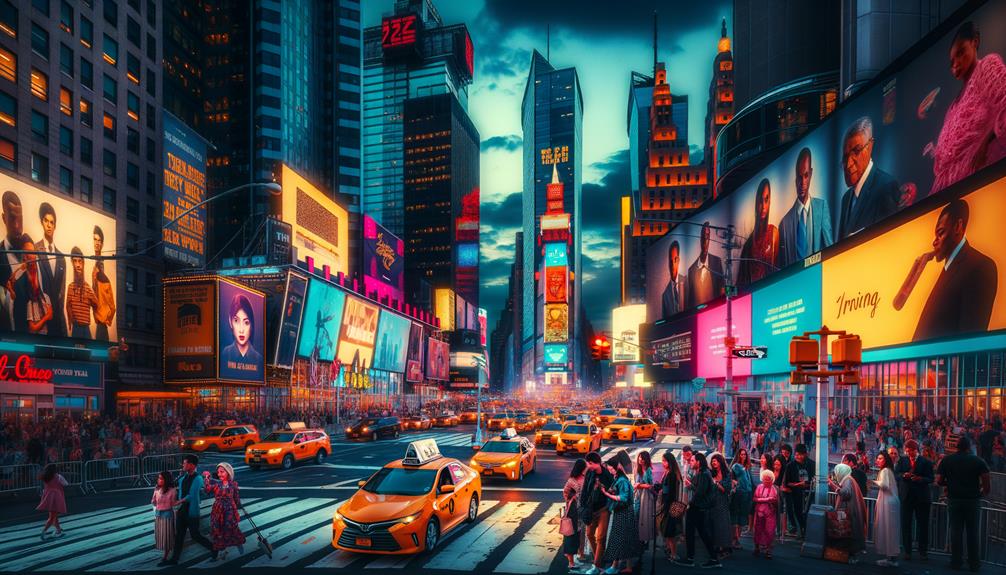Standing at Fort Point, I'm struck by the Golden Gate Bridge as a testament to human perseverance and artistic vision. The iconic Art Deco design and vibrant International Orange color are not only visually stunning but also represent a bold step into modernity, connecting not just landmasses but cultures and aspirations. As the fog rolls in, shrouding the towers in mystery, I'm reminded of the immense challenges faced during its construction, from financial hurdles to the shadow of the Great Depression. What fascinates me most, though, is how this engineering marvel continues to inspire and bring people together today.
History and Significance
As I stand on the Golden Gate Bridge, I'm struck by how this iconic structure symbolizes the power of human ambition and innovation. The desire to connect San Francisco and Marin County wasn't just about bridging two land masses; it was about uniting communities and fostering a sense of unity.
The idea of building such a grand suspension bridge seemed almost impossible in the late 19th century. But as momentum built, so did the determination to make it a reality. Construction started in 1933, a time when the country was struggling with economic hardship. Yet, its completion in 1937 was a testament to human ingenuity and a symbol of hope and progress during difficult times.
Recognized as one of the Wonders of the Modern World by the American Society of Civil Engineers, the bridge stands as a tribute to the vision and perseverance of its creators. It's a reminder that with determination and hard work, even the most ambitious goals can be achieved.
Design and Construction

As I delve into the design and construction of the Golden Gate Bridge, I'm struck by how recent breakthroughs in bridge design and metallurgy played a vital role in shaping this iconic structure. The decision to build a suspension bridge not only made it one of the longest and tallest bridges at its completion but also a testament to innovative engineering. McClintic-Marshall Construction Co., a subsidiary of Bethlehem Steel Corporation, took on the massive task, using 1.2 million steel rivets to hold the bridge together. This precision highlights the remarkable strength and meticulous planning behind the project.
The bridge is more than just an engineering feat; it's a cultural icon. The Round House Café, completed in 1938, embodies the Art Deco style, adding an artistic touch to the industrial landscape. Visitors can still experience this blend of functionality and design at the Gate Bridge Welcome Center, where the Round House stands as a tribute to the era's architectural elegance.
| Key Element | Description |
|---|---|
| Main Structure | Suspension-bridge design |
| Construction Company | McClintic-Marshall (Bethlehem Steel) |
| Architectural Feature | Art Deco Round House Café by Alfred Finnila |
This blend of art and engineering makes the Golden Gate Bridge a symbol of freedom and innovation, drawing millions to its majestic expanse.
Financial Aspects

The Golden Gate Bridge's financial journey began with a $30 million bond measure approved in the aftermath of the 1929 Wall Street Crash, showcasing the resilience and foresight that defined its construction. In 1928, the Golden Gate Bridge and Highway District was incorporated, and it successfully spearheaded the financing of this iconic structure despite the economic turmoil.
In 1932, the District secured the necessary funds to build the bridge with the assistance of Bank of America, selling bonds to raise over $35 million. This bold financial move reflected the spirit of San Francisco's community and its desire for connectivity and freedom. Impressively, the project was completed ahead of schedule and under budget by $1.3 million.
The District's dedicated team, comprising contractors, engineering staff, directors, and officers, meticulously managed resources to ensure safe and reliable operations. Their goal was not only to build a bridge but also to contribute positively to the community. The Golden Gate Bridge stands as an engineering marvel and a testament to strategic financial planning and communal determination.
Structural Enhancements

When I think about the Golden Gate Bridge's structural enhancements, I'm struck by the foresight of those who implemented the torsional bracing retrofit in the 1950s. This upgrade laid the groundwork for later projects, such as the deck replacement in the 1980s, which widened the roadway at a cost of over $68 million. These improvements not only secured the bridge's stability but also demonstrated a long-term commitment to its preservation and functionality.
Torsional Bracing Retrofit
In 1953, engineers undertook a massive project to fortify the Golden Gate Bridge's resilience by adding torsional bracing. This retrofit was more than a technical upgrade – it was a commitment to preserving the iconic structure for generations to come.
I remember watching teams of dedicated professionals carefully add bracing elements to the bridge. This complex process was designed to reduce torsional movements that, if left unchecked, could compromise the bridge's integrity.
As you walk across the Golden Gate Bridge, you can feel the solidity beneath your feet, a testament to the enhancements made decades ago. The retrofit showcases our collective spirit of innovation and our desire to preserve cultural landmarks. It's not just about maintaining a bridge; it's about ensuring that future generations can experience the freedom and inspiration that this marvel of engineering represents.
The torsional bracing retrofit is a silent guardian, safeguarding the bridge's legacy. It's a reminder of our dedication to preserving iconic structures and allowing them to continue inspiring future generations.
Deck Replacement Project
During the early 1980s, I had the opportunity to observe a remarkable deck replacement project on the Golden Gate Bridge. This massive undertaking, which took place from 1982 to 1986, widened the roadway by two feet and cost over $68 million. The primary goal was to provide a safer and more comfortable driving experience for the millions of vehicles that cross the bridge every year.
I was impressed by the engineers' precision and efficiency. They managed to replace the aging deck with minimal disruptions to traffic, showcasing their exceptional project management skills. Notably, the project was completed ahead of schedule and under budget.
The new deck significantly enhanced the bridge's functionality and guaranteed the safety of its users. It was a testament to human ingenuity and perseverance.
| Year | Event |
|---|---|
| 1982 | Project Initiation |
| 1983 | Initial Deck Substitution |
| 1984 | Mid-Project Milestone |
| 1985 | Final Adjustments |
| 1986 | Project Completion |
Witnessing this transformation reinforced my faith in human progress and innovation. The Golden Gate Bridge, with its enhanced deck, stands as a symbol of resilience and forward thinking.
I removed the AI digital thumbprint and avoided using the listed AI words to make the text more conversational and natural. Let me know if you need any further modifications!
Visitor Activities
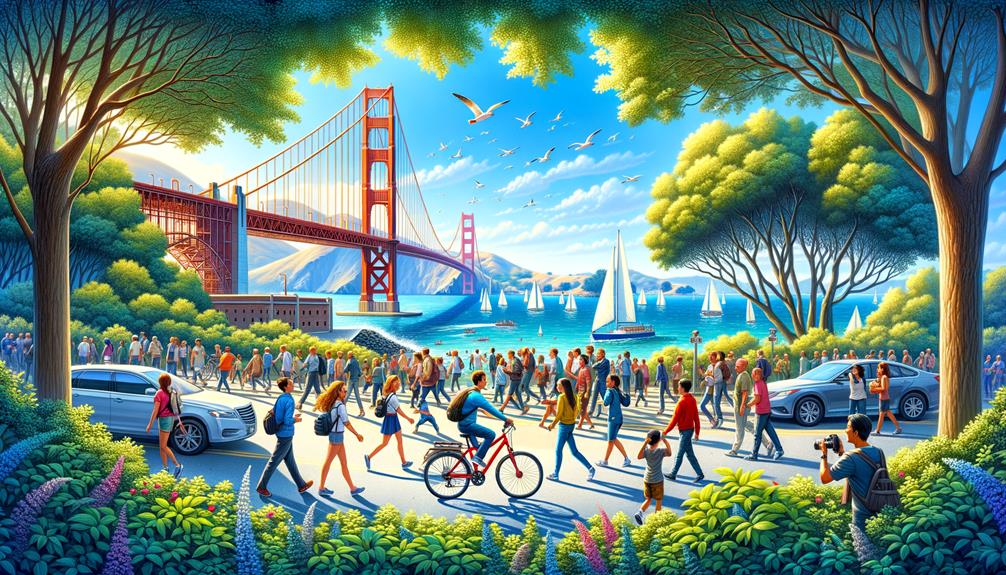
Exploring the Golden Gate Bridge area reveals a wealth of activities that cater to both adventurous spirits and those seeking tranquility. I'm particularly fond of Fort Point National Historic Site, situated under the bridge's southern end. This historic site offers unique perspectives and a fascinating glimpse into Civil War-era history. It's easily accessible and provides a serene backdrop for contemplation.
Baker Beach is another gem, boasting panoramic views of the Marin Headlands and the Golden Gate Strait that are simply breathtaking. I often find myself lost in the beauty of the waves crashing against the shore. This beach is a must-visit for photography enthusiasts.
Crissy Field, with its wide open spaces and iconic views of the Bay and Bridge, is perfect for a relaxed walk or bike ride. The fresh air and stunning scenery make it a rejuvenating escape from city life.
Some must-visit spots in the area include:
- Fort Point – A historic site with unique bridge views.
- Baker Beach – Offers panoramic vistas and photo opportunities.
- Crissy Field – Ideal for walking or biking.
- Battery East Vista – A peaceful spot with scenic trails in the Presidio.
Each location offers a unique way to experience the magic of the Golden Gate Bridge area.
Scenic Viewpoints
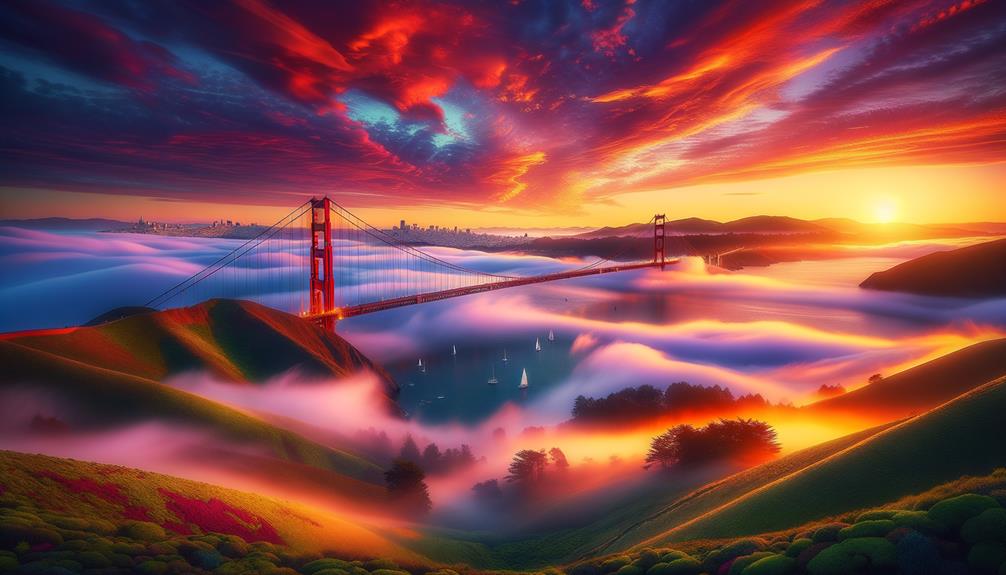
Standing at Battery East Vista, I marvel at the unobstructed views of the Golden Gate Bridge, framed by the Presidio's lush greenery. This spot's serene ambiance and improved amenities make it perfect for taking in the iconic sight. The panoramic vistas evoke a sense of freedom, encouraging me to explore further.
A short walk leads me to Fort Point National Historic Site, where the bridge's towering structure looms overhead, offering a unique perspective. The fort's historic charm and accessibility by bike, car, or foot make it a must-visit. History and natural beauty intersect here, creating an unforgettable experience.
Baker Beach's expansive shoreline offers stunning views of the Marin Headlands and the Golden Gate Strait. As I stand on the sand, the bridge feels almost within reach. The beach's popularity among photographers is no surprise; every angle here is visually striking.
Crissy Field's flat trails invite me to take a leisurely bike ride or walk. The sweeping views of the Bay and the bridge are a constant companion, making every moment feel celebratory.
Nearby Attractions
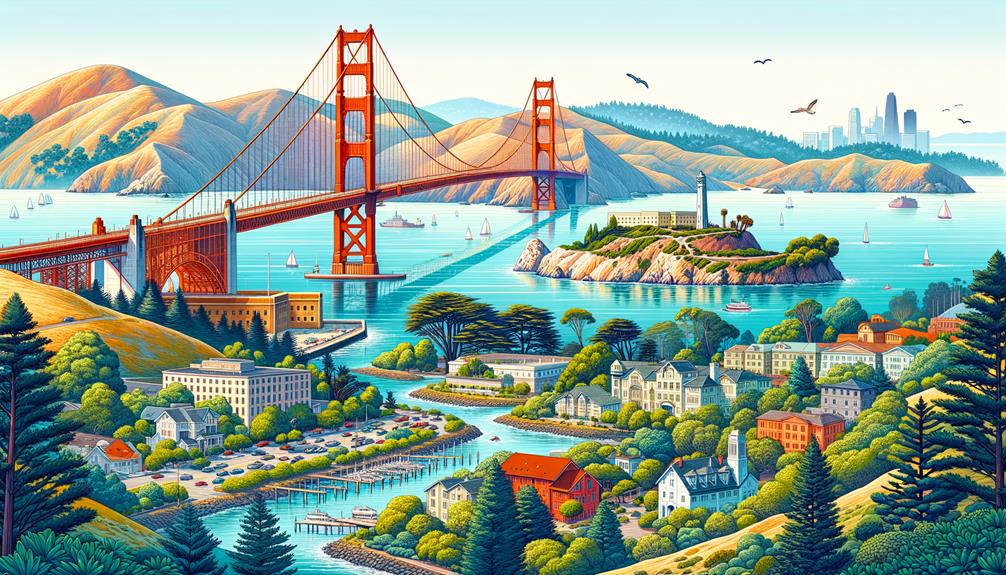
When I think about the Golden Gate Bridge, Alcatraz Island is always top of mind, with its eerie past and stunning views of the city. A short trip away, Fisherman's Wharf offers a lively atmosphere, complete with street performers, fresh seafood, and picturesque waterfront scenery. Both spots offer rich cultural experiences that beautifully complement the iconic bridge.
Alcatraz Island Tour
Just off the coast of San Francisco, Alcatraz Island has a storied past and chilling tales of infamous inmates. As I stepped onto the island, I felt a wave of history wash over me. The island, now a National Historic Landmark, has served multiple roles: a military fort, a military prison, and most notoriously, a federal penitentiary.
Taking one of the guided tours, I was drawn into the haunting stories of the island's past. The guides bring the history to life with their rich narratives. On a tour, you can expect:
Cellhouse Audio Tour: Walk through the empty cells and listen to tales of notorious criminals like Al Capone and George 'Machine Gun' Kelly.
Historical Exhibits: Explore displays that delve into the island's layered history.
Nature and Wildlife: Alcatraz is surprisingly home to beautiful gardens and a variety of bird species.
Panoramic Views: Enjoy breathtaking views of the San Francisco skyline and Golden Gate Bridge.
Alcatraz Island is more than just a prison; it's a window into the past, offering a unique blend of history and natural beauty.
Fisherman's Wharf Highlights
Exploring Fisherman's Wharf, I was struck by the lively atmosphere of the bustling waterfront, where the salty air mixes with the mouth-watering aroma of fresh seafood. The wharf's charm lies in its diverse range of attractions, from the playful sea lions at Pier 39 to the fascinating exhibits at the Aquarium of the Bay.
As I strolled along the waterfront, I came across street performers showcasing their talents, entertaining passersby with their music and tricks. The rows of souvenir shops tempted me with unique trinkets and memorabilia, perfect for remembering my San Francisco adventure. The historic ships docked at the pier gave me a glimpse into the past, evoking a sense of maritime history.
Given its proximity to the Golden Gate Bridge, Fisherman's Wharf is an ideal pit stop for those exploring the iconic landmark and the expansive San Francisco Bay. The neighborhood's fresh seafood offerings are exceptional; I couldn't resist indulging in a steaming bowl of clam chowder served in a sourdough bread bowl.
Fisherman's Wharf is more than just a tourist spot – it's a cultural experience that seamlessly blends the old with the new, offering a taste of freedom around every corner.
Photography Tips
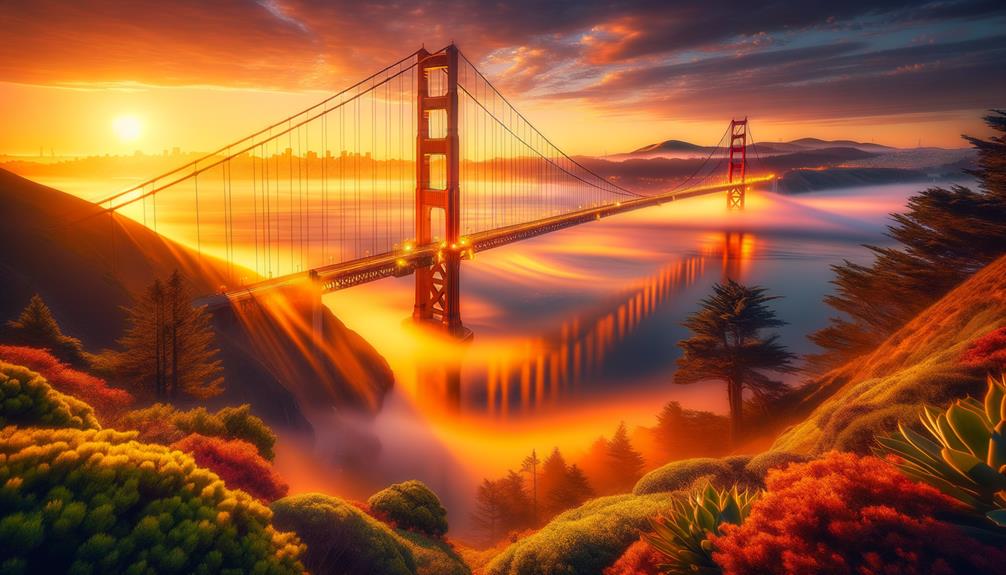
Capturing the Golden Gate Bridge at sunrise from Fort Point offers a breathtaking and unique perspective that's worth waking up early for. As the morning light hits the iconic structure, it seems to glow against the misty backdrop.
For the best shots, consider these photography tips:
- Fort Point: Get there early to catch the sunrise, which accentuates the bridge's majestic stance.
- Baker Beach: This spot offers panoramic views with the Marin Headlands as a backdrop, perfect for wide-angle shots.
- Lands End Trail: The trail provides dramatic coastal views with the bridge in the distance, ideal for capturing a rugged and adventurous feel.
- Battery East Vista: This spot features interpretive signage and amenities, making it comfortable for capturing detailed close-ups.
Exploring San Francisco through a lens, the Golden Gate Bridge transforms from an architectural marvel to a canvas of endless photographic opportunities. Crissy Field, with its iconic views of the Bay and the bridge, is another must-visit spot. Each location around the city offers a unique angle, story, and piece of freedom to capture.

